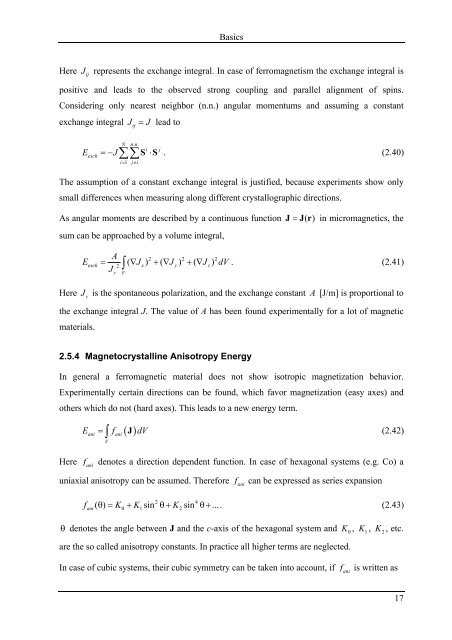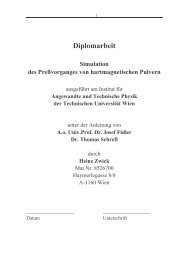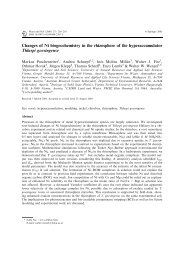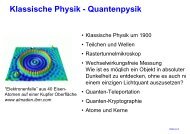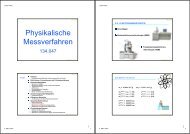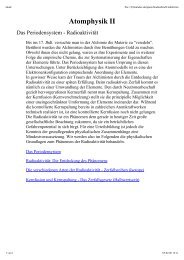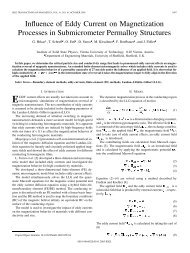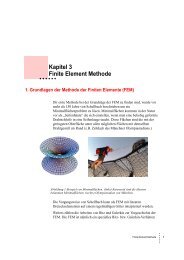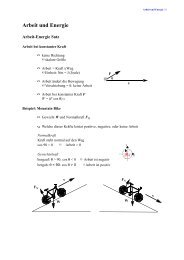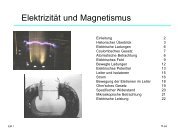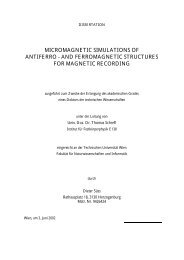Read Back Signals in Magnetic Recording - Research Group Fidler
Read Back Signals in Magnetic Recording - Research Group Fidler
Read Back Signals in Magnetic Recording - Research Group Fidler
Create successful ePaper yourself
Turn your PDF publications into a flip-book with our unique Google optimized e-Paper software.
Basics<br />
Here J ij represents the exchange <strong>in</strong>tegral. In case of ferromagnetism the exchange <strong>in</strong>tegral is<br />
positive and leads to the observed strong coupl<strong>in</strong>g and parallel alignment of sp<strong>in</strong>s.<br />
Consider<strong>in</strong>g only nearest neighbor (n.n.) angular momentums and assum<strong>in</strong>g a constant<br />
exchange <strong>in</strong>tegral Jij � J lead to<br />
N n. n.<br />
i j<br />
Eexch =−J ∑∑S ⋅S<br />
. (2.40)<br />
i= 1 j≠i The assumption of a constant exchange <strong>in</strong>tegral is justified, because experiments show only<br />
small differences when measur<strong>in</strong>g along different crystallographic directions.<br />
As angular moments are described by a cont<strong>in</strong>uous function J = J() r <strong>in</strong> micromagnetics, the<br />
sum can be approached by a volume <strong>in</strong>tegral,<br />
A<br />
E = ( ∇ J ) + ( ∇ J ) + ( ∇J<br />
) dV<br />
2 ∫ . (2.41)<br />
2 2 2<br />
exch<br />
J s V<br />
x y z<br />
Here J s is the spontaneous polarization, and the exchange constant A [J/m] is proportional to<br />
the exchange <strong>in</strong>tegral J. The value of A has been found experimentally for a lot of magnetic<br />
materials.<br />
2.5.4 Magnetocrystall<strong>in</strong>e Anisotropy Energy<br />
In general a ferromagnetic material does not show isotropic magnetization behavior.<br />
Experimentally certa<strong>in</strong> directions can be found, which favor magnetization (easy axes) and<br />
others which do not (hard axes). This leads to a new energy term.<br />
ani ani<br />
V<br />
( )<br />
E = ∫ f J dV<br />
(2.42)<br />
Here f ani denotes a direction dependent function. In case of hexagonal systems (e.g. Co) a<br />
uniaxial anisotropy can be assumed. Therefore f ani can be expressed as series expansion<br />
f ( θ ) = K + K s<strong>in</strong> θ+ K s<strong>in</strong> θ+ ... . (2.43)<br />
ani<br />
2 4<br />
0 1 2<br />
θ denotes the angle between J and the c-axis of the hexagonal system and 0 K , 1 K , 2<br />
are the so called anisotropy constants. In practice all higher terms are neglected.<br />
K , etc.<br />
In case of cubic systems, their cubic symmetry can be taken <strong>in</strong>to account, if f ani is written as<br />
17


